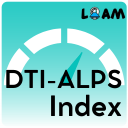Difference between revisions of "Documentation/Nightly/Extensions/DTI ALPS"
Acsenrafilho (talk | contribs) m Tag: 2017 source edit |
Acsenrafilho (talk | contribs) m |
||
| Line 31: | Line 31: | ||
Overall, DTI-ALPS represents a promising approach for studying the PVS and its implications in neurological health and disease. Its application may contribute to advancing our understanding of brain physiology and pathology, potentially leading to improved diagnosis, treatment, and management strategies for a range of neurological conditions. | Overall, DTI-ALPS represents a promising approach for studying the PVS and its implications in neurological health and disease. Its application may contribute to advancing our understanding of brain physiology and pathology, potentially leading to improved diagnosis, treatment, and management strategies for a range of neurological conditions. | ||
| − | <gallery widths="500px" perrow="2"> | + | <gallery widths="500px" height="500px" perrow="2"> |
Image:DTI-ALPS-sc-1.png|First screen panel of DTI-ALPS module | Image:DTI-ALPS-sc-1.png|First screen panel of DTI-ALPS module | ||
Image:DTI-ALPS-sc-2.png|DTI-ALPS module with index calculated | Image:DTI-ALPS-sc-2.png|DTI-ALPS module with index calculated | ||
Revision as of 12:57, 17 April 2024
Home < Documentation < Nightly < Extensions < DTI ALPS
|
For the latest Slicer documentation, visit the read-the-docs. |
Introduction and Acknowledgements
|
This work was funded by University of Campinas, Brazil. More information on the website Unicamp website. | |||||
|
Extension Description
Diffusion Tensor Image Analysis along the Perivascular Space (DTI-ALPS) is a method proposed by Toshiaki Taoka et al. in 2017 to investigate the perivascular space (PVS) using diffusion tensor imaging (DTI). The PVS is a system of interstitial fluid-filled spaces surrounding blood vessels in the brain, playing a crucial role in waste clearance and neurovascular regulation.
DTI-ALPS utilizes DTI data to quantify the directional diffusion of water molecules within the brain's PVS. By applying a novel algorithm, DTI-ALPS distinguishes the PVS from adjacent tissues, enabling the precise assessment of PVS morphology and alterations. This method offers several advantages. Firstly, it provides non-invasive imaging of the PVS, allowing for longitudinal studies and investigation of various neurological conditions. Additionally, DTI-ALPS enables the assessment of PVS integrity and changes associated with aging, vascular diseases, and neurodegenerative disorders, offering potential insights into disease mechanisms and diagnostic markers.
Overall, DTI-ALPS represents a promising approach for studying the PVS and its implications in neurological health and disease. Its application may contribute to advancing our understanding of brain physiology and pathology, potentially leading to improved diagnosis, treatment, and management strategies for a range of neurological conditions.
Modules
- Diffusion Tensor Image Analysis Along the Perivascular Space (DTI-ALPS): DTI-ALPS Module
Use Cases
- Use Case 1: Obtain the DTI-ALPS index calculation from standard DTI image and propers anatomical labels (see details at <ref>Taoka 2017 paper<\ref>)
- The DTI-ALPS index is a scalar value that represents the activity of the glymphatic system, which may be evaluated with diffusion images. Lower diffusivity along the perivascular space on DTI-APLS seems to reflect impairment of the glymphatic system.
Similar Modules
N/A
References
- Toshiaki Taoka et al. "Evaluation of glymphatic system activity with the diffusion MR technique: diffusion tensor image analysis along the perivascular space (DTI-ALPS) in Alzheimer's disease cases", (2017). Jpn J Radiol, Apr;35(4):172-178. PMID: 28197821 DOI: 10.1007/s11604-017-0617-z
Information for Developers
| Section under construction. |
Repositories:
- Source code: GitHub repository
- Issue tracker: open issues and enhancement requests






